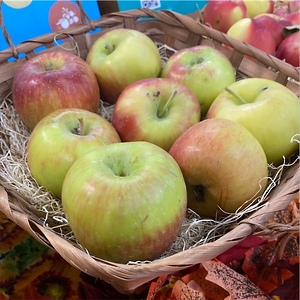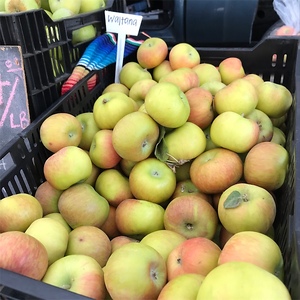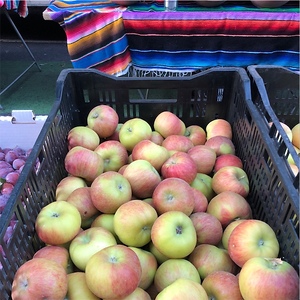


Waltana Apples
Estimated Inventory, lb : 0
This item was last sold on : 11/05/23
Description/Taste
Waltana apples are medium to large fruits, averaging 7 to 9 centimeters in diameter, and have a slightly flattened, round to conic shape. The fruits also bear faint ribbing and may feature flattened indentations around the apple base, a trait characteristic of the variety. The skin is smooth, thick, semi-glossy, and firm with a yellow-green base, covered in pale lenticels and variegated patches of light and dark red striped blush. The amount of striping and blush will vary between each fruit, and the maturity of the tree will also alter the coloring, with young trees producing more red fruits. Underneath the surface, the pale-yellow flesh is dense, crisp, aqueous, and moderately grained, encasing a central core filled with oval, black-brown seeds. Waltana apples have a mild, sweet, and subtly tangy flavor with notes of berries, almonds, apricots, and spices.
Seasons/Availability
Waltana apples are available in the late fall through early spring.
Current Facts
Waltana apples, botanically classified as Malus domestica, are a rare Californian variety belonging to the Rosaceae family. The crisp fruits were developed in the 20th century on an experimental farm near Humboldt County, California, and were the most famous variety bred by Albert Etter. Waltana apples were named after Etter’s brother and sister-in-law, Walter and Ana Etter, who were primarily responsible for marketing and cultivating the variety. Waltana apples are a late-season variety that requires an extended growing season, remaining on the tree even after the first frost when the leaves have dropped. Despite their challenging cultivation requirements, Waltana apples are a novel cultivar highly favored among apple enthusiasts in Northern California. The fruits can be stored through the early spring and are a multi-purpose apple, utilized in a wide array of fresh and cooked preparations.
Nutritional Value
Waltana apples are a good source of fiber to regulate the digestive tract and are a good source of potassium to balance fluid levels within the body. The apples also contain vitamin C to strengthen the immune system and lower amounts of folate, boron, and calcium.
Applications
Waltana apples are an all-purpose variety that is well suited to fresh and cooked applications, including baking, roasting, simmering, and poaching. The skin and flesh can be consumed, discarding the central core, and the apples can be eaten straight, out-of-hand as a snack or tossed into green salads for added texture. Waltana apples can also be chopped into fruit bowls, used as a fresh topping over oatmeal, pancakes, and ice cream, or pressed into juices for flavoring ciders, cocktails, and other beverages. Beyond fresh applications, Waltana apples hold their shape well and can be baked into pies, tarts, crumbles, cobblers, cakes, and muffins. The fruits can also be blended into applesauce, poached with warm spices as a dessert, or cooked into jams, preserves, and jellies. Waltana apples pair well with spices such as cardamom, nutmeg, clove, and cinnamon, vanilla, caramel, nut butter, meats such as poultry, pork, and turkey, and fruits such as oranges, mangoes, grapes, strawberries, cherries, and pears. Whole, unwashed Waltana apples will keep up to three months when stored in the crisper drawer of the refrigerator.
Ethnic/Cultural Info
Albert Etter was an unconventional California apple breeder known as “the man who made himself in the woods.” Etter began his career when he discovered a remote piece of land on a fishing trip in 1894. The 22-year-old obtained the land for free through the Homestead Act and named the property Ettersburg. Etter spent many years clearing the land and focused on breeding new varieties of strawberries and apples. With the help of his brothers, Etter performed thousands of crosses beginning in 1900 with select cultivated and wild varieties to develop apple cultivars with improved characteristics. Etter received sizable criticism from other pomologists for his unusual crossings throughout his career, but in the early 1900s, he created multiple cultivars suitable for commercial cultivation. In 1940, Etter partnered with the California Nursery Company, which was one of the most popular nurseries at the time, and introduced several varieties of apples. The fruits were not met with immediate success, but over time, as the orchard changed ownership and was remarketed, a few of Etter’s varieties were appreciated among apple enthusiasts. Waltana apples were considered Etter’s greatest achievement, but Etter also developed many other apples, including crimson gold, pink pearl, katherine, and wickson.
Geography/History
Waltana apples were bred by well-known apple breeder Albert Etter in the early 1900s in his experimental orchard located in Humboldt County, California. The variety was developed from the wagener apple and an unknown variety, with some experts believing it may have been a manx codlin apple. The fruits were selected for their extended storage capabilities and sweet taste and were heavily promoted through Etter’s brother, Walter Etter. Walter especially favored the new cultivar and planted the variety in a small orchard to commercially grow the fruits. Walter continued to manage the orchard until his death in 1946, and after many years of abandonment, Greenmantle Nurseries purchased the orchard and restored the variety in 1992. Original Waltana apple trees can still be found producing fruits in the restored orchard, and today, Waltana apples are primarily grown in home gardens and through small farms in Northern California.
Recipe Ideas
Recipes that include Waltana Apples. One










